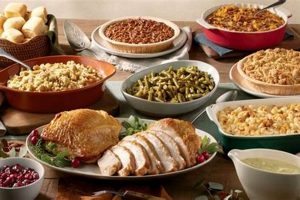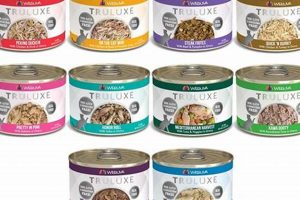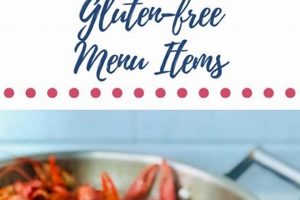A compilation of edible items excluding gluten, a protein found in wheat, barley, and rye, and dairy, encompassing milk and its derivatives, forms a dietary guide for individuals with specific health needs or preferences. This resource typically outlines acceptable foods like fruits, vegetables, certain grains, meats, poultry, and non-dairy alternatives, offering a structured approach to meal planning. For instance, a diet adhering to these restrictions might include rice, quinoa, lean protein sources, and plant-based milk alternatives.
Adherence to a diet excluding specific proteins and milk products can be crucial for managing conditions such as celiac disease, non-celiac gluten sensitivity, lactose intolerance, and dairy allergies. Such dietary modifications can lead to improved digestive health, reduced inflammation, and alleviation of associated symptoms. Historically, these restrictions have gained recognition as awareness of food sensitivities has increased, leading to a wider availability of suitable food options and resources.
The subsequent sections will delve into specific categories of foods that conform to both restrictions, explore practical considerations for implementation, and discuss strategies for maintaining a balanced and nutritionally complete diet while adhering to these requirements. Detailed examples and potential challenges will be addressed, providing a comprehensive overview for effective dietary management.
Successful adherence to simultaneous gluten and dairy restrictions necessitates careful planning and informed choices. The following tips are intended to assist individuals in effectively managing such dietary needs.
Tip 1: Thorough Label Reading is Paramount. All packaged goods must be scrutinized for hidden sources of gluten and dairy. Ingredients such as modified food starch, malt extract, whey, and casein can indicate the presence of restricted substances.
Tip 2: Prioritize Whole, Unprocessed Foods. A diet based primarily on naturally gluten-free and dairy-free items, such as fruits, vegetables, lean proteins, and legumes, minimizes the risk of inadvertent exposure and maximizes nutrient intake.
Tip 3: Explore Alternative Grains and Flours. Experiment with grains like quinoa, brown rice, amaranth, and gluten-free oat products. When baking, utilize flours made from rice, tapioca, almond, or coconut, understanding that these may require adjustments to recipes.
Tip 4: Embrace Plant-Based Dairy Substitutes. Numerous non-dairy alternatives are available, including milk, yogurt, and cheese made from almonds, cashews, coconuts, soy, or oats. Evaluate the ingredient lists for added sugars or undesirable additives.
Tip 5: Plan Meals in Advance. Proactive meal planning reduces the likelihood of making impulsive decisions that could compromise dietary adherence. Prepare shopping lists and batch-cook meals to ensure convenient access to appropriate foods.
Tip 6: Be Vigilant When Dining Out. Communicate dietary needs clearly to restaurant staff. Inquire about preparation methods and ingredients to avoid cross-contamination. Opt for establishments with dedicated gluten-free and dairy-free menus or extensive ingredient transparency.
Tip 7: Supplement Strategically. Individuals following restricted diets may be at risk for nutrient deficiencies. Consider consulting a healthcare professional to assess the need for supplementation with vitamins and minerals, such as vitamin D, calcium, iron, and B vitamins.
Implementing these guidelines promotes successful management of combined dietary limitations, contributing to improved health and well-being.
The subsequent section will address common challenges encountered while maintaining these restrictions and offer practical solutions for overcoming them.
1. Allowed grains.
The identification and selection of allowed grains is a cornerstone of constructing a dietary plan that excludes both gluten and dairy. Gluten, found in wheat, barley, and rye, necessitates the inclusion of alternative grains to provide carbohydrates, fiber, and essential nutrients. The absence of dairy from the diet further emphasizes the importance of grains as a significant energy source. Failure to incorporate appropriate grains can result in nutritional deficiencies and an unsustainable dietary approach. For example, individuals transitioning to a gluten and dairy-free diet may substitute wheat-based pasta with brown rice pasta or use quinoa as a base for salads and bowls.
The types of grains considered acceptable within the confines of a protein and milk free dietary plan significantly impact its feasibility and palatability. Grains such as brown rice, quinoa, amaranth, buckwheat, millet, and certified gluten-free oats provide versatile options for meal planning. These grains can be incorporated into various dishes, from breakfast cereals and side dishes to main courses and baked goods. Proper preparation techniques, such as soaking and rinsing grains, can enhance digestibility and nutrient absorption. Furthermore, the availability of processed products made from these grains, such as breads, crackers, and cereals, broadens dietary choices and improves adherence to the combined dietary restrictions.
In summary, the strategic selection of allowed grains is a vital component of a successful gluten and dairy-free dietary management. These grains not only provide essential nutrients and energy but also offer culinary versatility, supporting long-term adherence to the dietary restrictions. The ongoing development of new grain-based products and improved processing techniques further expands the options available, making this dietary approach more accessible and sustainable. The careful consideration of allowed grains contributes directly to the overall nutritional adequacy and success of managing a combined set of dietary restrictions.
2. Plant-based milk.
Plant-based milk alternatives are pivotal in constructing a comprehensive dietary guide that excludes both gluten and dairy. These beverages serve as direct substitutes for cow’s milk, offering a critical source of nutrients and culinary functionality while adhering to specified dietary restrictions. Their role extends beyond simple replacement, influencing the overall nutritional profile and versatility of a dietary regimen free from gluten and dairy.
- Nutritional Contribution
Plant-based milk alternatives can provide essential vitamins and minerals such as calcium, vitamin D, and vitamin B12, which are typically obtained from dairy milk. Fortification is common, but nutritional profiles vary significantly across different types (almond, soy, coconut, oat, rice). Selection must consider individual needs and potential deficiencies arising from the elimination of dairy. For instance, unsweetened almond milk may be low in calories but also low in protein, requiring alternative protein sources in the diet.
- Culinary Applications
These alternatives function similarly to dairy milk in various culinary applications, including baking, cooking, and beverage preparation. However, their performance can differ; soy milk may curdle at high temperatures, while oat milk’s creamy texture makes it ideal for coffee. Selecting the appropriate plant-based milk for a specific recipe is crucial for achieving desired results. Bakers may need to adjust recipes to accommodate varying moisture content and protein levels.
- Ingredient Considerations
Careful examination of ingredient labels is necessary to ensure the chosen plant-based milk is free from gluten and dairy derivatives. Some products may contain hidden sources of gluten or additives derived from dairy, such as caseinates. Awareness of potential cross-contamination during manufacturing is also important. For example, a plant-based milk produced in a facility that also processes wheat or dairy may pose a risk to sensitive individuals.
- Allergen Management
While offering a solution for dairy avoidance, plant-based milk alternatives can introduce new allergen concerns. Soy, nuts (almonds, cashews, coconuts), and seeds (sunflower, hemp) are common bases, each carrying its own allergenic potential. Individuals with allergies to these ingredients must carefully select alternatives based on tolerated ingredients. A person allergic to both dairy and almonds would need to explore options such as oat or rice milk, verifying their production process to avoid cross-contamination.
In conclusion, plant-based milk alternatives are integral to a comprehensive gluten- and dairy-free diet, offering both nutritional support and culinary versatility. However, informed selection based on nutritional profiles, culinary applications, ingredient considerations, and allergen management is essential. The successful integration of these alternatives requires diligence and awareness to ensure the diet remains both safe and nutritionally adequate. The continued innovation in this sector allows for greater dietary diversity and adherence to specific requirements.
3. Lean protein sources.
The incorporation of lean protein sources is a fundamental aspect of dietary planning for individuals adhering to restrictions of both gluten and dairy. Protein is crucial for tissue repair, enzyme production, and overall metabolic function. This becomes particularly significant when gluten and dairy are excluded, as these food groups often contribute substantially to protein intake in unrestricted diets. The strategic selection of lean protein sources ensures nutritional adequacy and supports the maintenance of lean body mass.
- Role in Satiety and Weight Management
Lean protein promotes satiety, which can be especially beneficial when dietary restrictions limit food choices. Adequate protein intake helps regulate appetite, reduce cravings, and prevent overconsumption of less nutritious foods. For instance, including grilled chicken breast or baked tofu in meals can help individuals feel fuller for longer, aiding in weight management while adhering to gluten- and dairy-free guidelines. This is particularly important as gluten-free and dairy-free processed foods can sometimes be higher in refined carbohydrates and sugars to compensate for the absence of gluten and dairy.
- Sources and Variety
Diverse lean protein sources should be included in the dietary plan to ensure a broad spectrum of amino acids and nutrients. Examples include poultry (chicken, turkey), fish (salmon, cod), lean cuts of beef and pork, eggs (if tolerated), legumes (beans, lentils), tofu, tempeh, and edamame. Variety is essential to prevent dietary monotony and ensure adequate intake of micronutrients. A person might alternate between lentil soup, grilled fish, and chicken stir-fries throughout the week to meet protein needs while adhering to the dietary requirements.
- Preparation Methods
The preparation methods used for lean protein sources greatly influence their nutritional value and suitability within a restricted diet. Baking, grilling, steaming, and poaching are preferred over frying, which adds unnecessary fats. Marinades and sauces should be carefully scrutinized to avoid hidden sources of gluten or dairy. For example, a marinade made with tamari (gluten-free soy sauce) and olive oil is a safe option, whereas a creamy sauce might contain dairy. Individuals should be vigilant about cross-contamination during food preparation, using separate cutting boards and utensils for protein and other ingredients.
- Nutritional Considerations
While focusing on lean protein, it’s important to consider the overall nutritional profile of each source. Some protein sources, such as fatty fish, provide omega-3 fatty acids, which are beneficial for heart health. Others, like legumes, are high in fiber and promote digestive health. Pairing lean protein with gluten-free grains and non-dairy vegetables ensures a balanced and nutrient-rich diet. Consulting a registered dietitian or nutritionist can provide personalized guidance on meeting protein needs and addressing any potential nutrient deficiencies while adhering to a gluten- and dairy-free regimen.
Integrating lean protein sources strategically within the context of a protein and milk free food selection is essential for maintaining overall health and well-being. It not only ensures adequate protein intake but also supports satiety, weight management, and a balanced nutritional profile. The selection and preparation of lean protein sources should be approached with careful consideration of ingredients, preparation methods, and potential nutritional benefits, contributing to the long-term success and sustainability of this dietary approach.
4. Safe fruits, vegetables.
The inclusion of safe fruits and vegetables constitutes a critical, foundational element of a dietary regimen designed to exclude gluten and dairy. Naturally devoid of both gluten and dairy, these food groups serve as the bedrock of a balanced and sustainable eating pattern. A deficiency in fruit and vegetable consumption compromises nutritional adequacy, potentially leading to vitamin and mineral deficiencies, and reducing dietary fiber intake, essential for digestive health. For instance, a diet primarily composed of gluten-free processed foods devoid of sufficient produce can be nutritionally inadequate, despite adhering to the initial restrictions. The unrestricted and varied consumption of fruits and vegetables ensures essential micronutrient intake and supports overall physiological function.
Furthermore, the selection of preparation methods for produce within a gluten- and dairy-free dietary context demands consideration to prevent cross-contamination or the inadvertent introduction of restricted ingredients. Raw fruits and vegetables, requiring only thorough washing, pose minimal risk. However, cooked preparations necessitate scrutiny of added ingredients such as sauces, dressings, or seasonings, which may contain hidden sources of gluten or dairy. For example, steamed broccoli is inherently safe, but the addition of a cream-based sauce would violate the dietary requirements. Similarly, a pre-made fruit salad may contain a yogurt-based dressing, rendering it unsuitable. A practical application involves opting for simple preparations, such as roasting vegetables with olive oil and herbs, or dressing salads with a vinaigrette made from oil, vinegar, and gluten-free mustard.
In summary, safe fruits and vegetables are an indispensable component of a gluten- and dairy-free dietary strategy. Their inherent freedom from gluten and dairy allows for unrestricted consumption, providing essential vitamins, minerals, and fiber. The primary challenge lies in maintaining their safety during preparation by avoiding cross-contamination and carefully scrutinizing added ingredients. The strategic inclusion of diverse and properly prepared produce ensures a nutritionally complete and sustainable eating pattern that supports overall health and well-being within the specified dietary constraints.
5. Ingredient label scrutiny.
Ingredient label scrutiny constitutes a critical and unavoidable aspect of adhering to a “gluten dairy free food list.” The complex nature of food manufacturing and processing frequently results in the presence of hidden gluten and dairy components in unexpected products. Therefore, the meticulous examination of ingredient lists is essential to ensure compliance with dietary restrictions and to prevent adverse reactions. This practice requires a thorough understanding of common gluten and dairy-derived ingredients, as well as a familiarity with deceptive labeling practices.
The practical significance of ingredient label scrutiny is evident in numerous real-world scenarios. For instance, modified food starch, a common food additive, can be derived from wheat, making it unsuitable for individuals avoiding gluten. Similarly, seemingly innocuous ingredients like natural flavorings or maltodextrin can contain trace amounts of dairy. Individuals following a dietary plan excluding both gluten and dairy must diligently review labels for these and other potential contaminants. This careful evaluation extends beyond the primary ingredients to include all listed components, including processing aids and incidental additives.
In conclusion, ingredient label scrutiny is not merely a recommendation, but a necessity for those managing protein and milk free dietary restrictions. The presence of hidden gluten and dairy components in a wide range of processed foods mandates a rigorous and informed approach to label reading. The consistent application of this practice is paramount for maintaining dietary adherence, preventing adverse reactions, and ensuring the overall success of the dietary strategy. The complexity of the food supply necessitates continuous vigilance and education regarding potential sources of contamination.
6. Cross-contamination avoidance.
Cross-contamination avoidance is a fundamental practice for individuals adhering to a dietary list excluding both gluten and dairy. The unintentional introduction of gluten or dairy into otherwise compliant foods compromises the integrity of the diet, potentially triggering adverse health effects. Strict adherence to preventative measures is therefore paramount.
- Dedicated Utensils and Cookware
The use of separate utensils, cutting boards, and cookware specifically designated for the preparation of gluten-free and dairy-free meals is critical. Shared equipment may harbor residual traces of gluten or dairy even after thorough cleaning. For example, a wooden cutting board, due to its porous nature, can retain gluten even after washing. Similarly, a saucepan used to heat milk could contaminate subsequent dairy-free preparations. Dedicated equipment mitigates this risk.
- Surface Hygiene and Cleaning Protocols
Thorough cleaning and sanitization of all food preparation surfaces are essential. Gluten and dairy particles can persist on countertops, sinks, and other surfaces. Effective cleaning protocols involve the use of hot, soapy water followed by a sanitizing agent. In commercial settings, adherence to established food safety standards is imperative. For instance, wiping down a counter with a cloth that was previously used to clean up spilled flour can reintroduce gluten, negating the benefits of a gluten-free recipe.
- Storage Practices
Proper storage of gluten-free and dairy-free foods is necessary to prevent cross-contamination. These items should be stored in separate, clearly labeled containers and placed on shelves above gluten-containing or dairy-containing foods to prevent accidental spillage or contact. Open containers of flour or other potential contaminants should be sealed tightly. A gluten-free bag of chips stored next to an open container of wheat flour risks contamination, rendering the snack unsuitable for consumption.
- Restaurant and Food Service Communication
When dining out or ordering food, clear and direct communication with restaurant staff is crucial. Individuals must inquire about ingredients, preparation methods, and potential sources of cross-contamination. Requesting that meals be prepared in a separate area of the kitchen with dedicated utensils can minimize risk. A simple request such as “I have celiac disease and a dairy allergy, can you please ensure my meal is prepared separately?” can significantly reduce the chance of exposure.
These facets of cross-contamination avoidance collectively contribute to the successful implementation of a dietary plan based on a gluten and dairy-free food list. By mitigating the risk of unintentional exposure to these substances, individuals can minimize adverse health effects and maintain dietary adherence. The meticulous application of these principles is essential for long-term well-being.
7. Nutrient supplementation.
Adherence to a “gluten dairy free food list” necessitates careful consideration of nutrient supplementation due to the potential for deficiencies arising from the elimination of major food groups. Gluten-containing grains and dairy products serve as primary sources for several essential nutrients. The restrictive nature of the diet may limit intake of vitamins, minerals, and other vital compounds, underscoring the importance of targeted supplementation. For example, the elimination of dairy may result in inadequate calcium and vitamin D intake, impacting bone health. Similarly, avoidance of fortified wheat products can reduce folate and iron consumption, potentially leading to anemia. Therefore, supplementation serves as a mechanism to mitigate the nutritional risks associated with this dietary regimen.
Specific nutrients warrant particular attention in the context of gluten and dairy restrictions. Calcium and vitamin D are crucial for bone density and overall skeletal health, particularly in growing children and older adults. Iron is essential for oxygen transport and preventing iron-deficiency anemia, a concern especially for menstruating women. B vitamins, including folate, play a vital role in cellular function and energy metabolism. Omega-3 fatty acids, often found in fatty fish, may be deficient due to limited dietary choices. A practical approach involves consulting with a healthcare professional or registered dietitian to assess individual needs and determine appropriate supplementation strategies. Blood tests can identify existing deficiencies, guiding the selection of specific supplements and dosages. Supplementation, however, should not replace a balanced diet but rather complement it.
In conclusion, nutrient supplementation is an integral component of managing a dietary protocol centered around a “gluten dairy free food list”. The elimination of key food groups increases the risk of nutritional inadequacies, necessitating a proactive approach to supplementation. Careful consideration of specific nutrient needs, consultation with healthcare professionals, and strategic supplementation can mitigate potential deficiencies and ensure the long-term health and well-being of individuals following this dietary pattern. It is crucial to recognize that supplementation is not a substitute for a well-planned, nutrient-dense diet but rather a tool to support and enhance nutritional status within the specified dietary constraints.
Frequently Asked Questions
The following questions address common concerns and misunderstandings associated with adhering to a dietary protocol based on a gluten and dairy-free food list. Clarity regarding these issues is crucial for the successful implementation and maintenance of this dietary approach.
Question 1: Is a diet based on a protein and milk free food selection inherently healthier than a standard diet?
A diet excluding specified proteins and milk products is not inherently healthier. Its nutritional value depends entirely on the composition of the alternative food choices made. A diet rich in fruits, vegetables, lean proteins, and whole gluten-free grains can be highly nutritious. Conversely, a diet reliant on processed gluten-free and dairy-free products, often high in refined carbohydrates and added sugars, may be less healthful than a balanced standard diet.
Question 2: Can one effectively manage a dietary plan avoiding protein and milk without consulting a healthcare professional?
While it is possible to initiate such a dietary plan independently, consultation with a registered dietitian or healthcare provider is strongly recommended. A professional can assess individual nutritional needs, identify potential deficiencies, and provide guidance on appropriate food choices and supplementation strategies, ensuring a nutritionally balanced and sustainable dietary approach.
Question 3: Are all products labeled “gluten-free” and “dairy-free” entirely safe for individuals with celiac disease or dairy allergies?
The presence of a “gluten-free” or “dairy-free” label does not guarantee complete safety. “Gluten-free” labeling standards vary across countries. Moreover, cross-contamination during manufacturing or food preparation remains a risk. Individuals with celiac disease or dairy allergies should scrutinize ingredient lists and inquire about manufacturing practices to minimize potential exposure.
Question 4: Does adherence to a dietary plan restricting both specified proteins and milk invariably lead to weight loss?
This dietary modification does not automatically result in weight loss. Weight management is primarily governed by calorie balance. If caloric intake exceeds expenditure, weight gain can occur even while adhering to these restrictions. Successful weight loss requires a comprehensive approach that includes calorie control, regular physical activity, and mindful eating practices.
Question 5: Is the elimination of specified proteins and milk necessary for optimal health in all individuals?
Elimination of these substances is not necessary for optimal health in the general population. These dietary restrictions are primarily indicated for individuals diagnosed with celiac disease, non-celiac gluten sensitivity, dairy allergies, or lactose intolerance. Unless a documented medical condition necessitates these restrictions, a balanced and varied standard diet is typically sufficient for maintaining health.
Question 6: Are plant-based milk alternatives nutritionally equivalent to cow’s milk?
Plant-based milk alternatives exhibit varying nutritional profiles. While some are fortified with calcium, vitamin D, and other nutrients to approximate cow’s milk, their protein content and overall nutritional composition can differ significantly. Careful comparison of nutrition labels is essential to ensure adequate nutrient intake when substituting plant-based milk for cow’s milk.
These answers provide essential clarity regarding common misconceptions and challenges. The complexities involved necessitate careful consideration and informed decision-making.
The subsequent section will delve into practical strategies for maintaining a gluten and dairy-free lifestyle while navigating social situations and travel.
Gluten Dairy Free Food List
This exposition has elucidated critical facets of dietary management centered around a compilation of edible items that exclude specified proteins and milk products. The comprehensive review encompassed allowed grains, plant-based milk alternatives, lean protein sources, safe fruits and vegetables, the imperative of ingredient label scrutiny, the necessity of cross-contamination avoidance, and the potential role of nutrient supplementation. Each element contributes to a sustainable approach for individuals requiring or electing to adhere to these dietary constraints.
Effective application of the information presented necessitates diligent implementation of the outlined strategies. As the understanding of food sensitivities evolves and the availability of suitable products expands, individuals must remain informed and proactive in managing their dietary needs. The long-term success of a dietary plan based on a gluten dairy free food list hinges upon informed choices, meticulous planning, and a commitment to nutritional adequacy, ultimately fostering improved health and well-being.


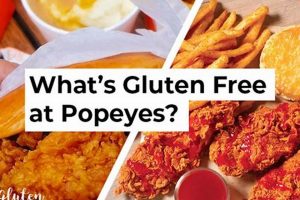
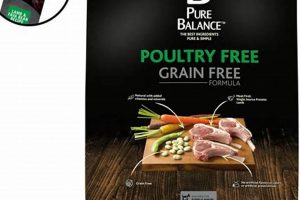
![Gluten-Free Thai: What to Eat & Recipes [Guide] World’s Most Delicious Foods: Must-Try Dishes from Every Country Gluten-Free Thai: What to Eat & Recipes [Guide] | World’s Most Delicious Foods: Must-Try Dishes from Every Country](https://lisasfoods.com/wp-content/uploads/2025/12/th-442-300x200.jpg)
